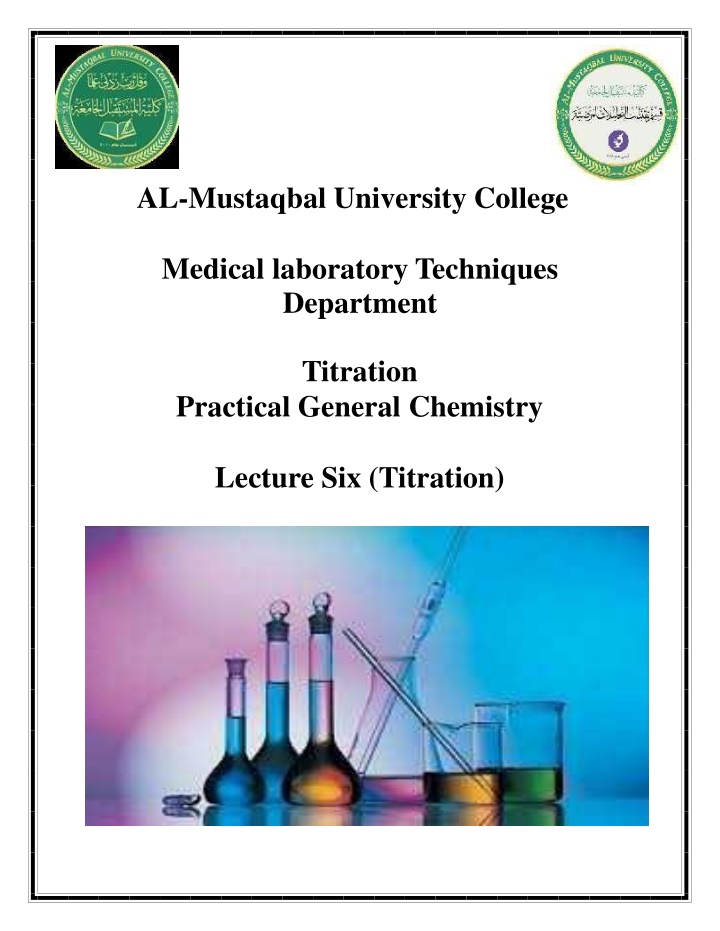
Titration in General Chemistry Lectures
Explore the technique of titration used in determining solution concentration. Learn about standard solutions, end points, and types of titrations like acid-base, complexometric, redox, and precipitation. Follow a practical acid-base titration experiment involving sodium hydroxide and hydrochloric acid.
Download Presentation

Please find below an Image/Link to download the presentation.
The content on the website is provided AS IS for your information and personal use only. It may not be sold, licensed, or shared on other websites without obtaining consent from the author. If you encounter any issues during the download, it is possible that the publisher has removed the file from their server.
You are allowed to download the files provided on this website for personal or commercial use, subject to the condition that they are used lawfully. All files are the property of their respective owners.
The content on the website is provided AS IS for your information and personal use only. It may not be sold, licensed, or shared on other websites without obtaining consent from the author.
E N D
Presentation Transcript
AL-Mustaqbal University College Medical laboratory Techniques Department Titration Practical General Chemistry Lecture Six (Titration)
A technique for determining the concentration of a solution by measuring the volume of one solution needed to completely react with another solution. Titration process involves addition of solution of known concentration from burette to the measured volume of analyte. It is based on the complete chemical reaction between the analyte and the reagent (titrant) of known concentration. The solution of unknown concentration but known volume put in conical flask. The solution of known concentration put in burette.
Asolution of known concentration is called the standard solution. Types of standard solution: 1. Primary standard solution: It has certain properties: Extremely pure. Highly stable. It should not be hygroscopic. It should be stable toward air. It should not undergo any side-reaction. Can be weighed easily. It should be available and not too expensive. 2. Secondary standard solution: It has certain properties: Less pure than primary standard. Less stable than primary standard. Cannot be weighed easily.
It is a theoretical point where the amount of two reactants are just equivalent. It is a practical point at which the reaction is observed to be complete, this point is usually observe with the help of indicator. An auxiliary substance (either weak acids or weak bases) which helps in the usual detection of the completion of the titration process at the end point. acid-base titrations, are generally used indicators. They change their color within a certain pH range.
1. Acid-base titrations 2. Complexometric titrations 3. Redox titrations. 4. Precipitation titrations Acid base Titration (neutralization): A sample of unknown concentration of acid is estimated with a known concentrated base or vice-verse. In this experiment, we will quantitatively study an acid-base reaction. Strong acids and strong bases dissociate completely in water: Determination normality of sodium hydroxide solution by a standard solution of hydrochloric acid: HCl reacts with sodium hydroxide according to the following equation:
The eq.wt. of both the HCl and NaOH is equal to their molecularweights. Note: Both the acid and base are strong, any indicator may be used. Burette Stand Conical flask Funnel Beaker Pipette Graduated Cylinder Dropper Washing bottle. HCl solution (standard) known normality. NaOH solution of unknown normality. Phenolnaphthalene indicator. Standardization of the NaOH solution by titrating with standard of HCl solution: 1Transfer by a pipette 5 ml of unknown NaOH solution to a conical flask. 2Add to the conical flask two or three drops of phenolnaphthalene indicator.
3- Fill the burette with HCl solution to zero mark. 4 Titrate NaOH against HCl until the color of solution changes from colorless to pink. 5 Repeat the experiment three times and record your results.
The volume of NaOH used in three times is 5 ml. 2. Average volume of HCl used = (calculated from burette). 3. Then the unknown concentration calculated by using the law:






















